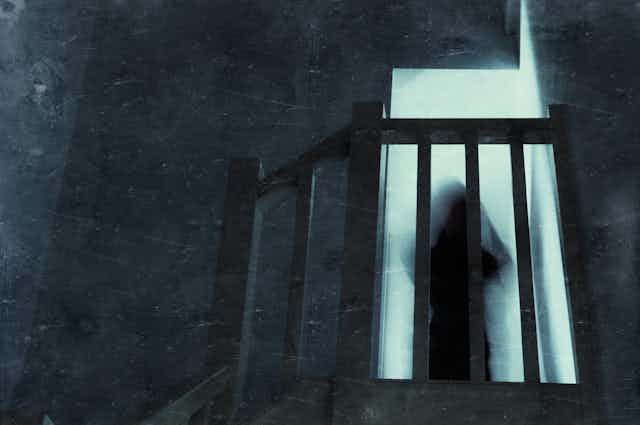

Barry Markovsky ne travaille pas, ne conseille pas, ne possède pas de parts, ne reçoit pas de fonds d'une organisation qui pourrait tirer profit de cet article, et n'a déclaré aucune autre affiliation que son organisme de recherche.
University of South Carolina apporte un financement en tant que membre adhérent de The Conversation US.
Voir les partenaires de The Conversation France

Curious Kids is a series for children of all ages. If you have a question you’d like an expert to answer, send it to curiouskidsus@theconversation.com.
Is it possible for there to be ghosts? – Madelyn, age 11, Fort Lupton, Colorado
Certainly, lots of people believe in ghosts – a spirit left behind after someone who was alive has died.
In a 2021 poll of 1,000 American adults, 41% said they believe in ghosts, and 20% said they had personally experienced them. If they’re right, that’s more than 50 million spirit encounters in the U.S. alone.
That includes the owner of a retail shop near my home who believes his place is haunted. When I asked what most convinced him of this, he sent me dozens of eerie security camera video clips. He also brought in ghost hunters who reinforced his suspicions.
Some of the videos show small orbs of light gliding around the room. In others, you can hear faint voices and loud bumping sounds when nobody’s there. Others show a book flying off a desk and products jumping off a shelf.
Many ghostly encounters are due to the way your brain interprets certain sights and sounds.It’s not uncommon for me to hear stories like this. As a sociologist, some of my work looks at beliefs in things like ghosts, aliens, pyramid power and superstitions.
Along with others who practice scientific skepticism, I keep an open mind while maintaining that extraordinary claims require extraordinary evidence. Tell me you had a burger for lunch, and I’ll take your word for it. Tell me you shared your fries with Abraham Lincoln’s ghost, and I’ll want more evidence.
In the “spirit” of critical thinking, consider the following three questions:
People may think they’re experiencing ghosts when they hear strange voices, see moving objects, witness balls or wisps of light or even translucent people.
Yet no one describes ghosts as aging, eating, breathing or using bathrooms – despite plumbers receiving many calls about toilets “ghost-flushing.”
So could ghosts be made of a special kind of energy that hovers and flies without dissipating?
If that’s the case, that means when ghosts glow, move objects and make sounds, they are acting like matter – something that takes up space and has mass, like wood, water, plants and people. Conversely, when passing through walls or vanishing, they must not act like matter.
But centuries of physics research have found nothing like this exists, which is why physicists say ghosts can’t exist.
And so far, there is no proof that any part of a person can continue on after death.
The real truth is out there, says this ghost skeptic.Never before in history have people recorded so many ghost encounters, thanks in part to mobile phone cameras and microphones. It seems there would be great evidence by now. But scientists don’t have it.
Instead, there are lots of ambiguous recordings sabotaged by bad lighting and faulty equipment. But popular television shows on ghost hunting convince many viewers that blurry images and emotional reactions are proof enough.
As for all the devices ghost hunters use to capture sounds, electrical fields and infrared radiation – they may look scientific, but they’re not. Measurements are worthless without some knowledge of the thing you’re measuring.
When ghost hunters descend on an allegedly haunted location for a night of meandering and measurement, they usually find something they later deem paranormal. It may be a moving door (breeze?), a chill (gap in the floorboards?), a glow (light entering from outside?), electrical fluctuations (old wiring?), or bumps and faint voices (crew in other rooms?).
Whatever happens, ghost hunters will draw a bull’s-eye around it, interpret that as “evidence” and investigate no further.
There’s a scientific explanation for spooky sightings.Personal experiences with ghosts can be misleading due to the limitations of human senses. That’s why anecdotes can’t substitute for objective research. Alleged hauntings usually have plenty of non-ghostly explanations.
One example is that retail establishment in my neighborhood. I reviewed the security camera clips and gathered information about the store’s location and layout, and the exact equipment used in the recordings.
First, the “orbs”: Videos captured many small globes of light seemingly moving around the room.
In reality, the orbs are tiny particles of dust wafting close to the camera lens, made to “bloom” by the camera’s infrared lights. That they appear to float around the room is an optical illusion. Watch any orb video closely and you’ll see they never go behind objects in the room. That’s exactly what you’d expect with dust particles close to the camera lens.
Next, voices and bumps: The shop is in a busy corner mini-mall. Three walls abut sidewalks, loading zones and parking areas; an adjacent store shares the fourth. The security camera mics probably recorded sounds from outdoors, other rooms and the adjacent unit. The owner never checked for these possibilities.
Then, the flying objects: The video shows objects falling off the showroom wall. The shelf rests on adjustable brackets, one of which wasn’t fully seated in its slot. The weight of the shelf caused the bracket to settle into place with a visible jerk. This movement sent some items tumbling off the shelf.
Then, the flying book: I used a simple trick to recreate the event at home: a hidden string taped inside a book’s cover, wrapped around the kitchen island, and tugged by my right hand out of camera range.
Experience the mystery of the flying book.Now I can’t prove there wasn’t a ghost in the original video. The point is to provide a more plausible explanation than “it must have been a ghost.”
One final consideration: Virtually all ghostly experiences involve impediments to making accurate perceptions and judgments – bad lighting, emotional arousal, sleep phenomena, social influences, culture, a misunderstanding of how recording devices work, and the prior beliefs and personality traits of those who claim to see ghosts. All of these hold the potential to induce unforgettable ghostly encounters.
But all can be explained without ghosts being real.
Hello, curious kids! Do you have a question you’d like an expert to answer? Ask an adult to send your question to CuriousKidsUS@theconversation.com. Please tell us your name, age and the city where you live.
And since curiosity has no age limit – adults, let us know what you’re wondering, too. We won’t be able to answer every question, but we will do our best.